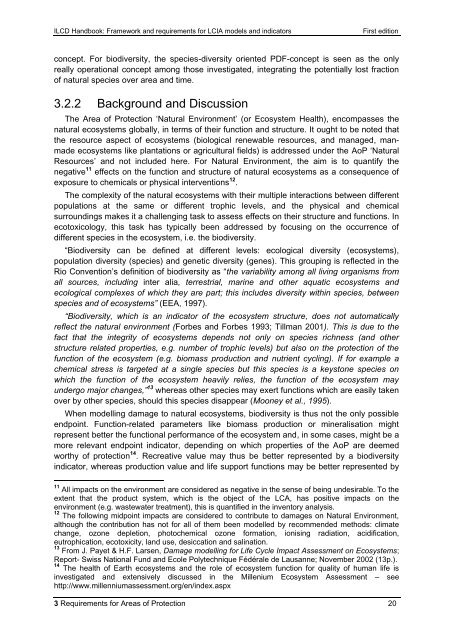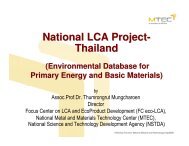ILCD Handbook: Framework and requirements for LCIA models and ...
ILCD Handbook: Framework and requirements for LCIA models and ...
ILCD Handbook: Framework and requirements for LCIA models and ...
You also want an ePaper? Increase the reach of your titles
YUMPU automatically turns print PDFs into web optimized ePapers that Google loves.
<strong>ILCD</strong> <strong>H<strong>and</strong>book</strong>: <strong>Framework</strong> <strong>and</strong> <strong>requirements</strong> <strong>for</strong> <strong>LCIA</strong> <strong>models</strong> <strong>and</strong> indicators First edition<br />
concept. For biodiversity, the species-diversity oriented PDF-concept is seen as the only<br />
really operational concept among those investigated, integrating the potentially lost fraction<br />
of natural species over area <strong>and</strong> time.<br />
3.2.2 Background <strong>and</strong> Discussion<br />
The Area of Protection ‗Natural Environment‘ (or Ecosystem Health), encompasses the<br />
natural ecosystems globally, in terms of their function <strong>and</strong> structure. It ought to be noted that<br />
the resource aspect of ecosystems (biological renewable resources, <strong>and</strong> managed, manmade<br />
ecosystems like plantations or agricultural fields) is addressed under the AoP ‗Natural<br />
Resources‘ <strong>and</strong> not included here. For Natural Environment, the aim is to quantify the<br />
negative 11 effects on the function <strong>and</strong> structure of natural ecosystems as a consequence of<br />
exposure to chemicals or physical interventions 12 .<br />
The complexity of the natural ecosystems with their multiple interactions between different<br />
populations at the same or different trophic levels, <strong>and</strong> the physical <strong>and</strong> chemical<br />
surroundings makes it a challenging task to assess effects on their structure <strong>and</strong> functions. In<br />
ecotoxicology, this task has typically been addressed by focusing on the occurrence of<br />
different species in the ecosystem, i.e. the biodiversity.<br />
―Biodiversity can be defined at different levels: ecological diversity (ecosystems),<br />
population diversity (species) <strong>and</strong> genetic diversity (genes). This grouping is reflected in the<br />
Rio Convention‘s definition of biodiversity as ―the variability among all living organisms from<br />
all sources, including inter alia, terrestrial, marine <strong>and</strong> other aquatic ecosystems <strong>and</strong><br />
ecological complexes of which they are part; this includes diversity within species, between<br />
species <strong>and</strong> of ecosystems” (EEA, 1997).<br />
“Biodiversity, which is an indicator of the ecosystem structure, does not automatically<br />
reflect the natural environment (Forbes <strong>and</strong> Forbes 1993; Tillman 2001). This is due to the<br />
fact that the integrity of ecosystems depends not only on species richness (<strong>and</strong> other<br />
structure related properties, e.g. number of trophic levels) but also on the protection of the<br />
function of the ecosystem (e.g. biomass production <strong>and</strong> nutrient cycling). If <strong>for</strong> example a<br />
chemical stress is targeted at a single species but this species is a keystone species on<br />
which the function of the ecosystem heavily relies, the function of the ecosystem may<br />
undergo major changes,” 13 whereas other species may exert functions which are easily taken<br />
over by other species, should this species disappear (Mooney et al., 1995).<br />
When modelling damage to natural ecosystems, biodiversity is thus not the only possible<br />
endpoint. Function-related parameters like biomass production or mineralisation might<br />
represent better the functional per<strong>for</strong>mance of the ecosystem <strong>and</strong>, in some cases, might be a<br />
more relevant endpoint indicator, depending on which properties of the AoP are deemed<br />
worthy of protection 14 . Recreative value may thus be better represented by a biodiversity<br />
indicator, whereas production value <strong>and</strong> life support functions may be better represented by<br />
11 All impacts on the environment are considered as negative in the sense of being undesirable. To the<br />
extent that the product system, which is the object of the LCA, has positive impacts on the<br />
environment (e.g. wastewater treatment), this is quantified in the inventory analysis.<br />
12 The following midpoint impacts are considered to contribute to damages on Natural Environment,<br />
although the contribution has not <strong>for</strong> all of them been modelled by recommended methods: climate<br />
change, ozone depletion, photochemical ozone <strong>for</strong>mation, ionising radiation, acidification,<br />
eutrophication, ecotoxicity, l<strong>and</strong> use, desiccation <strong>and</strong> salination.<br />
13 From J. Payet & H.F. Larsen, Damage modelling <strong>for</strong> Life Cycle Impact Assessment on Ecosystems;<br />
Report- Swiss National Fund <strong>and</strong> Ecole Polytechnique Fédérale de Lausanne; November 2002 (13p.).<br />
14 The health of Earth ecosystems <strong>and</strong> the role of ecosystem function <strong>for</strong> quality of human life is<br />
investigated <strong>and</strong> extensively discussed in the Millenium Ecosystem Assessment – see<br />
http://www.millenniumassessment.org/en/index.aspx<br />
3 Requirements <strong>for</strong> Areas of Protection 20



